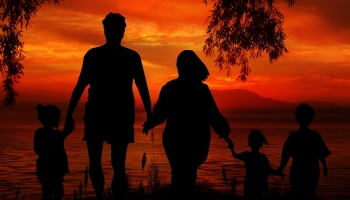Reading Time: 3 minutes
When you take a look at addiction and addiction trends, it’s easy to see that there is often a family dynamic to addiction. Addiction is not a solitary disease and impacts the whole family. Parents, siblings, and even grandparents and aunts and uncles feel the effects of the disease.
It hurts relationships, increases stress, and makes it so you can’t rely on nor trust your loved one. And when it comes to children, the impacts of addiction can lead to lifelong consequences, including an addiction of their own.
Addiction and Family Roles

Children of addicts are 4 times more likely to develop drug or alcohol issues.
When it comes to addiction, unhealthy family roles develop and codependency sets in, creating even more dysfunction.
- The Addict: The addict acts selfishly and his or her behaviors impact the rest of the family and how they interact with one another.
- The Caretaker: Often the one who feels responsibility for the family as a whole, the caretaker is often the worst enabler. These individuals may lie, hide behaviors, cover for the addict, and even give them money in an attempt to “keep things calm.” While their intention is often good, they either directly or indirectly help the addict use.
- The Hero: The family hero is an over-achiever who strives to make the family look good, even when things are falling apart. While they appear put together and high functioning to the outside world, they tend to be isolated and compulsive.
- The Mascot: The family mascot is the one who tries to keep everyone laughing so no one will start yelling or crying. The one cracking jokes and always being the funny guy, the mascot is really just keeping things superficial to avoid uncomfortable feelings.
- The Scapegoat: The scapegoat of the family is the one who can’t seem to get anything right and is always at blame. This person often engages in negative, attention-seeking behaviors, especially when attention is focused on the addict.
- The Lost Child: This is the individual who withdraws, not because they don’t care, but because they care too much. These individuals check out emotionally because their feelings become overwhelming and they can’t deal with the drama.
Breaking the Cycle of Addiction
When it comes to addiction within families, the first step is to recognize the dysfunction. Without this, recovery for anyone in the family becomes more difficult because they continue to not take ownership for their actions and the impacts that addiction has on the family.
When Enough Is Enough
Breaking the cycle of addiction is hard, not just for the addict, but for those that love him or her too. But eventually, with the right help and support, it is possible to reach a point where enough is enough and the family learns healthy and appropriate ways to interact, regardless if the addict gets better.
Here are the things that a family needs to do to break the cycle of addiction and stop letting drugs and alcohol hurt family relationships.
- Set appropriate boundaries
- Know the signs of manipulation
- Learn new behavior patterns
- Eliminate old learned behaviors
- Get educated on addiction and treatments
- Seek support
- Don’t give up
It’s the Children Who Suffer
While addiction impacts the whole family, there are none that impacted more than children living in an addicted household.
Approximately 8.3 million children in the US live with at least one addicted parent who is in need of addiction treatment. And there are at least 80 million children throughout the country who are impacted by addiction.
These children are four times more likely to develop drug or alcohol issues and continue the dysfunctional cycle of abuse that addiction brings. It’s time to stop and make a change.
